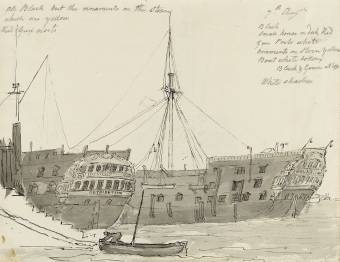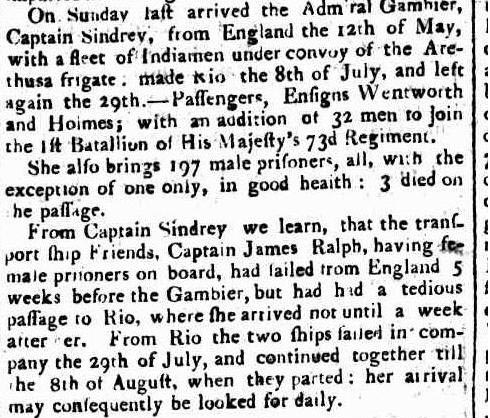Convict Ship Admiral Gambier (2)
1811
Embarked 200 men
Voyage 140 days
Deaths 3
Surgeon's Journal - No
Previous vessel: Providence arrived 2 July 1811
Next vessel: Friends arrived 10 October 1811
Note: Made the fastest direct passage from Rio to Port Jackson
Master Edward Sindrey
Convicts of the Admiral Gambier identified in the Hunter Valley region
Prisoners transported on the Admiral Gambier were convicted in counties in England, Scotland and Wales - York, Middlesex, Kent, Lincoln, Northampton, Warwick, Chester, Worcester, Sussex, Devon, Wiltshire, Essex, Bristol, Derby, Surrey, Somerset, Suffolk, Leicester, Hertford, Huntingdon, Hereford, Salop, Bedford, Dorset, Bucks, Oxford, Southampton, Cambridge, Cornwall, Edinburgh, Dumfries, Glasgow and Monmouth. There were also several soldiers who had been court-martialled.
The weather in England was remarked on by Louis Simond in Journal of a Tour and Residence in Great Britain, During the Years, as being particularly onerous in 1811........
January 14, 1811 - The winter has been felt severely in England; there has been much snow there, and the Thames has been frozen over. [2]
Prison Hulks
Pity the poor convicts living and working in the prison hulks moored on the Thames with freezing conditions added to their already grim and oppressive circumstances.Those men incarcerated in the Retribution hulk at Woolwich were embarked on the Admiral Gambier on 27th February 1811 and those on the Captivity hulk on 16th March 1811.
 Image : Retribution Hulk - National Maritime Museum....
Image : Retribution Hulk - National Maritime Museum....Military Guard
Passengers Ensign D'arcy Wentworth and Ensign Hugh Holmes, with an addition of 32 men to join the 1st Battalion of H. M. 73rd regiment arrived on the Admiral Gambier.Detachments of the 73rd arrived on the Dromedary, Indefatigable, Guildford, Hindostan, Indian, Archduke Charles, Ann, Fortune 1813, Providence 1811 and Admiral Gambier 1811
Departure
The Admiral Gambier departed England on 12th May 1811 with a fleet of Indiamen under convoy of the Arethusa frigate. She made Rio de Janeiro on the 8th July and departed there 29th July 1811.Port Jackson
 They arrived at Port Jackson 29 September 1811.
They arrived at Port Jackson 29 September 1811.Charles Bateson noted in The Convict Ships that the Admiral Gambier had made the fastest direct passage from Rio to Port Jackson having taken 62 days.[1]
One hundred and ninety-seven male prisoners came on the Admiral Gambier, three having died on the passage out :
William Sharp, died at sea the 11th of May, disease a watery brain.
John Hayball, at Rio Janeiro the 13th of July consumption.
John Brown, at sea, the 23d of August, of a pulmonic affliction.
One of the soldier's wives whose name was Mary Lyneham, died in Sydney after the ship came to anchor.[4]
Convict Muster
Governor Macquarie informed Lord Liverpool of the arrival in a dispatch in October 1811 -I have to inform your Lordship that I have, on all arrivals of convicts ships, ordered a muster to be immediately taken of the convicts on ship board by my Secretary and the Acting Commissary, and I afterwards take a muster of them myself so soon as landed, in order to ascertain the manner they have been treated during the voyage, and whether they have any complaints to prefer against the commander or surgeon of the ship in which they came.
By the previous muster I also acquire a knowledge of the trades or professions of the convicts, which enables me to appropriate them afterwards in the most advantageous way for Government, and at the same time most easy for themselves. I have much satisfaction in reporting to your Lordship that the convicts arrived by the four ships Indian, Providence, Admiral Gambier and Friends were in general in good health, having been well treated on board, and had no complaints to make against either the commanders or the surgeons. The male convicts arrived in those ships proved a very seasonable and acceptable supply for the colony, the settlers in general having been in great want of labourers to carry on their agricultural and grazing concerns.' [3]
The Indents for the Admiral Gambier include the name, where and when convicted and term of transportation as well as ticket of leave number if applicable. Fifteen of the prisoners had been tried in Scotland.
Convict Clothing
The following February (1812) Commissary William Broughton gave notice that the prisoners of the Admiral Gambier who were employed at Government labour were entitled to the summer issue of clothing only. This consisted for the men of One duck frock, one pair duck trousers, one cotton shirt, one pair of shoes and one leather cap; and for the women, one linen cloth jacket, one shift, one pair of shoes, one straw bonnet.Life in the Colony
Many of these convicts would have seen the effects of the hail and heavy rains that fell six weeks later. Crops were ruined and bridges and roads became impassable.Departure
The Admiral Gambier departed for England on 2 December 1811.Notes and Links
1). Richard Boots who later became Sexton at Newcastle arrived as a convict on the Admiral Gambier.2). Reuben Hanham arrived as a convict. In 1815 he applied to have his wife and children join him in the colony. Read Governor Macquarie's correspondence on his behalf and Hanham's Memorial in the Historical Records of Australia.
3). National Archives - Voyages: (1) From China 1812. pt Edward Lindsey. Lintin 5 Jul 1812 - 21 Aug Macao - 31 Dec Cape - 27 Jan 1813 St Helena - 18 May Blackwall.
4). Ensign D'arcy Wentworth of 73rd regiment was a son of D'Arcy Wentworth, principal surgeon at Sydney Hospital, and Catherine Crowley; he was a brother of William Charles Wentworth. D'arcy Wentworth married Elizabeth Macpherson, third daughter of the late Major Charles Macpherson, barrack-master general for Scotland, on 27 April 1826 at Edinburgh. There were no children of the marriage. In 1843 D'arcy Wentworth stood for election to represent the Northumberland boroughs in the Legislative Council. He was accompanied to Maitland by his brother W.C. Wentworth......Mr. Wentworth was carried to Cox's hotel. The Major was then placed in a chair, and the two gentlemen were carried from Cox's hotel p the Newcastle road to as far as the Catholic church, then along the street leading from the road past Mr. Keddie's and across the green in front of the gaol to Mr. Mayo's; where both gentlemen addressed the crowd from Mr. Mayo's counter. Maitland Mercury 24 June 1843
5). Edward Scarr arrived on the Admiral Gambier. He was one of four convicts who seized the Speedwell at Newcastle settlement in 1814 and were never heard from again.
6). Statement of the number of soldiers court-martialled - Estimates and Accounts
7). Although some convicts did manage to return from New South Wales to their country of birth, there is usually little to be found about them afterwards. The following article about John Spooner came to light because of the unusual circumstances:
SPOONER V BREWSTER June 8 1825 An action of trespass is maintainable for removing or defacing a tombstone at the suit of the party by whom it is erected or set up as the right to it vests in such person during his life and descends to his heir or representative after his death This was an action of trespass for defacing and damaging a tombstone At the trial before Lord Chief Justice Best at Westminster at the sittings after the last term it appeared that the plaintiff had some time since been transported for seven years that his daughter afterwards married a person by the name of Gravenor that she afterwards died when the plaintiff's wife purchased the stone in question and caused it to be placed at the head of her daughter's grave but it appeared that the daughter's husband had purchased and paid for the ground where his wife was buried The inscription on the stone was Sacred to the Memory of Elizabeth Gravenor and at the back was engraved the words The family grave of John and Sarah Spooner It was also proved that the stone was put up in 1816 and that in 1822 Gravenor claimed it and gave directions to the defendant to remove it and strike out the words The family grave of John and Sarah Spooner that he did so and removed it to his premises for that purpose when the plaintiff came and claimed it But the defendant refused to deliver it up and afterwards struck out the words The family grave of John and Sarah Spooner and caused the stone to be returned to the spot from which it was taken when the plaintiff commenced the present action for removing and defacing it ....continue
8). Thomas Richardson who arrived as a convict was mentioned by Governor Macquarie to Under Secretary Peel in correspondence dated 18th October 1811 when Governor Macquarie indicated he would show every degree of indulgence consistent with Richardson's situation and to endeavour to alleviate his sufferings as much as he could. (HRA, vol. VII, p.448)
9). Convict George King was a member of John Oxley's Lachlan River Expedition in 1817
10). Captain Edward Sindrey died in Hobart in April/ May 1821
11). Convicts of the Admiral Gambier identified in the Hunter Valley region
Thomas Ashley
Antonio Berringo / Berengo
Richard Boots
John Bourn
Jacob Bowden
Abraham Braham
John Brown
James Chilcott
Michael Doras
James Good
William Gray
Edward Harwood / Howard
James Lander
Thomas Lane
John Lee
William Leach
Phillip McLaughlan
Thomas McNamara/ Macnamara
George Miller
John Milligan
Thomas Noble
John Pearce
Thomas Powell/ Hall/ Lovell
David Rigby
Joseph Rowarth / Rauworth
James/ Joseph Rutherford
Edward Scarr / Scarl
Thomas Spencer
Joseph Spitharie
Jeremiah Sullivan
John Thomas
Robert Thomas
Alexander Thompsey
Joseph Walker
William White
References
[1] Bateson, Charles, The Convict Ships, 1787-1868.[2] Journal of a Tour and Residence in Great Britain, During the Years ..., Volume 2 By Louis Simond
[3] HR NSW Vol. VII
[4] Sydney Gazette 5 October 1811
↑